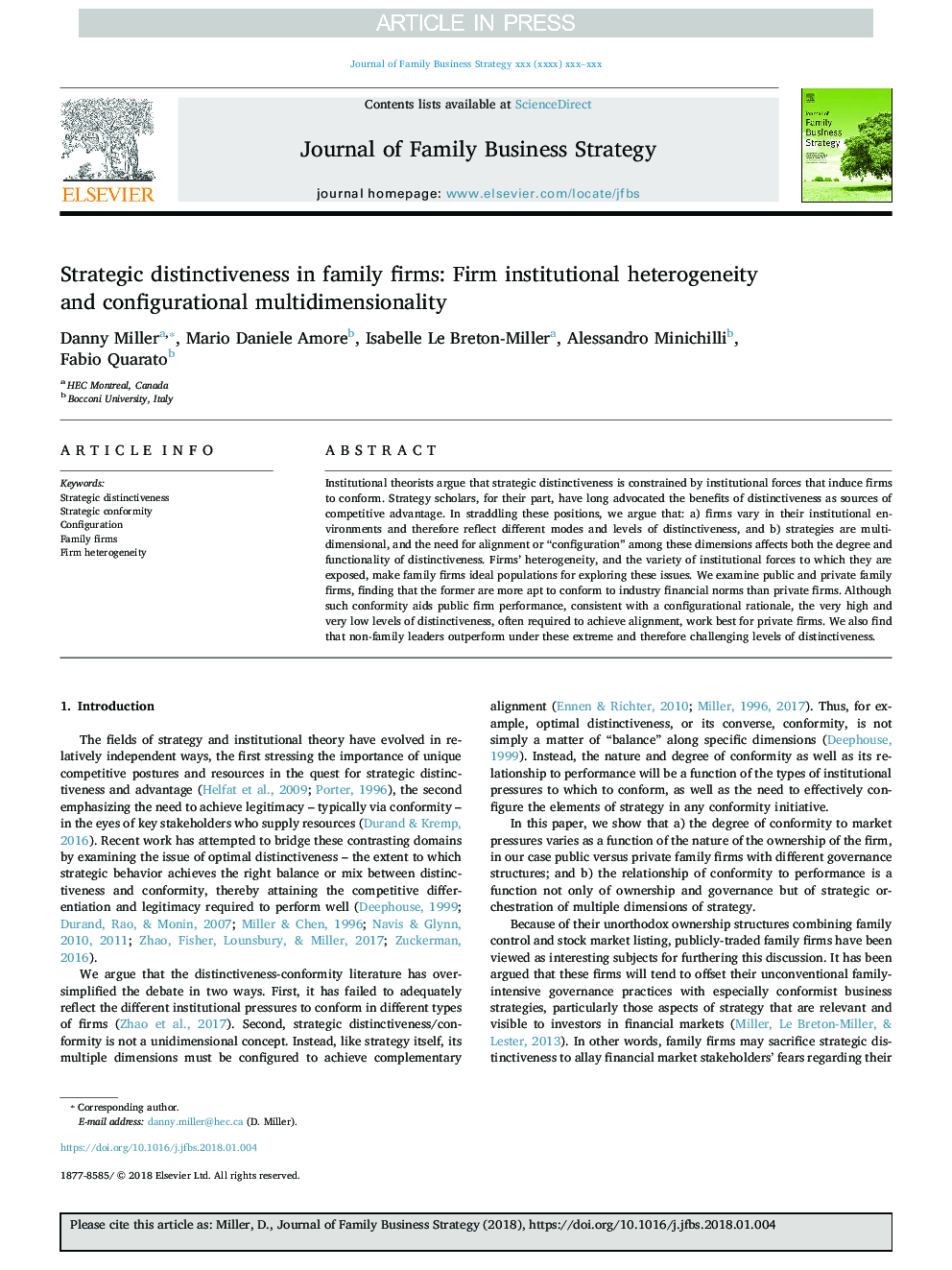| کد مقاله | کد نشریه | سال انتشار | مقاله انگلیسی | نسخه تمام متن |
|---|---|---|---|---|
| 7426262 | 1482879 | 2018 | 11 صفحه PDF | دانلود رایگان |
عنوان انگلیسی مقاله ISI
Strategic distinctiveness in family firms: Firm institutional heterogeneity and configurational multidimensionality
ترجمه فارسی عنوان
تمایز استراتژیک در شرکت های خانوادگی: ناهمگونی نهادی سازمانی و چند بعدی بودن پیکربندی
دانلود مقاله + سفارش ترجمه
دانلود مقاله ISI انگلیسی
رایگان برای ایرانیان
کلمات کلیدی
تمایز استراتژیک، انطباق استراتژیک، پیکربندی، شرکت های خانوادگی، ناهمگنی شرکت،
ترجمه چکیده
نظریهپردازان نهادی استدلال می کنند که تمایز استراتژیک توسط نیروهای نهادی که باعث برهم زدن شرکت ها می شود، محدود می شود. به عنوان مثال، پژوهشگران استراتژیک مدتهاست از مزایای تمایز به عنوان منابع مزیت رقابتی حمایت می کنند. در تحقق این موقعیت ها، ما استدلال می کنیم که: الف) شرکت ها در محیط های سازمانی خود متفاوت هستند و بنابراین منعکس کننده حالت ها و سطوح تمایز مختلف هستند و ب) استراتژی های چند بعدی و نیاز به هماهنگی یا پیکربندی در میان این ابعاد، هم درجه و هم ویژگی های تمایز را تحت تاثیر قرار می دهد. ناهمگونی شرکت ها و انواع نیروهای نهادی که در معرض آن قرار دارند، شرکت های خانوادگی را برای بررسی این مسائل به کار می بندند. ما شرکتهای خانوادگی خصوصی و خانوادگی را مورد بررسی قرار می دهیم و می دانیم که اولی ها نسبت به شرکای خصوصی با استانداردهای مالی صنعت منطبق هستند. اگر چه چنین تطبیقی به عملکرد شرکت عمومی، مطابق با یک منطق پیکربندی، سطح بسیار بالا و بسیار پایین تمایز، اغلب برای دستیابی به هماهنگی لازم است، برای شرکت های خصوصی بهتر است. ما همچنین می بینیم که رهبران غیر خانوادگی تحت این سطوح افراطی و به همین ترتیب سطوح متمایز تمایز فراتر می روند.
موضوعات مرتبط
علوم انسانی و اجتماعی
مدیریت، کسب و کار و حسابداری
کسب و کار و مدیریت بین المللی
چکیده انگلیسی
Institutional theorists argue that strategic distinctiveness is constrained by institutional forces that induce firms to conform. Strategy scholars, for their part, have long advocated the benefits of distinctiveness as sources of competitive advantage. In straddling these positions, we argue that: a) firms vary in their institutional environments and therefore reflect different modes and levels of distinctiveness, and b) strategies are multidimensional, and the need for alignment or “configuration” among these dimensions affects both the degree and functionality of distinctiveness. Firms' heterogeneity, and the variety of institutional forces to which they are exposed, make family firms ideal populations for exploring these issues. We examine public and private family firms, finding that the former are more apt to conform to industry financial norms than private firms. Although such conformity aids public firm performance, consistent with a configurational rationale, the very high and very low levels of distinctiveness, often required to achieve alignment, work best for private firms. We also find that non-family leaders outperform under these extreme and therefore challenging levels of distinctiveness.
ناشر
Database: Elsevier - ScienceDirect (ساینس دایرکت)
Journal: Journal of Family Business Strategy - Volume 9, Issue 1, March 2018, Pages 16-26
Journal: Journal of Family Business Strategy - Volume 9, Issue 1, March 2018, Pages 16-26
نویسندگان
Danny Miller, Mario Daniele Amore, Isabelle Le Breton-Miller, Alessandro Minichilli, Fabio Quarato,
